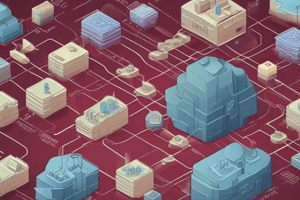Podcast
Questions and Answers
What is the primary function of the Presentation layer in the OSI model?
What is the primary function of the Presentation layer in the OSI model?
- Controling the start and end of a network connection
- Converting binary data into a human readable form (correct)
- Providing reliable transport of data
- Determining the path of data transmission
What type of address is used to identify devices at the Data Link layer?
What type of address is used to identify devices at the Data Link layer?
- Physical/MAC Address (correct)
- Session Address
- Logical/IP Address
- Network Address
Which protocol is responsible for reliable transport of data in the OSI model?
Which protocol is responsible for reliable transport of data in the OSI model?
- EIGRP
- TCP (correct)
- RIP
- OSPF
What is the main function of the Session layer in the OSI model?
What is the main function of the Session layer in the OSI model?
What type of address is used to identify devices at the Network layer?
What type of address is used to identify devices at the Network layer?
What is the process of adding headers and trailers to a data package?
What is the process of adding headers and trailers to a data package?
What is the main advantage of using OSI layers?
What is the main advantage of using OSI layers?
What is the function of the Physical layer (Layer 1) in the OSI model?
What is the function of the Physical layer (Layer 1) in the OSI model?
What is the purpose of the Session layer (Layer 5) in the OSI model?
What is the purpose of the Session layer (Layer 5) in the OSI model?
What is the term for protocols that can only be run by the vendor that developed them?
What is the term for protocols that can only be run by the vendor that developed them?
Flashcards are hidden until you start studying
Study Notes
OSI Layers
- 7 layers of the OSI model: Application, Presentation, Session, Transport, Network, Data Link, and Physical
- Each layer has a specific function and communicates with its peer layer on other devices
OSI Layer Functions
- Application (7): Any software/application that lets you connect to the network
- Presentation (6): Any file type that converts binary data into a human readable form (e.g. JPG, PNG, GIF, BMP, MP3, WAV, FLAC, MP4, AVI, MKV)
- Session (5): Controls the start and end of a network connection
- Transport (4): In charge of the reliable transport of data using TCP and UDP
- Network (3): Logical/IP Addressing and Path Determination using Routing Protocols (RIP, EIGRP, OSPF, BGP)
- Data Link (2): Physical/MAC Addressing and Error Detection using WAN Encapsulation types (HDLC, PPP, Frame-Relay)
- Physical (1): Transmission Medium Types (Copper, Fiber, Air) and Connector Types (EIA/TIA Standards)
Addresses
- 2 types of addresses: Physical (MAC Address) and Logical (IP Address)
- Physical Address (MAC Address): used by devices such as routers and switches
- Logical Address (IP Address): used for routing and IP communication
Encapsulation and De-Encapsulation
- Encapsulation: process of adding headers and trailers to data
- De-Encapsulation: process of removing headers and trailers from data
- PDU (Protocol Data Unit): packet of data with headers and trailers
- FCS (Frame Check Sequence): used for error detection in data transmission
Networking
- Networking: interconnection of devices to enable resource sharing
- Protocols: set of rules/instructions for data communication
- OSI Layer Advantages: Intervendor Operability, Ease of troubleshooting, Ease of Understanding
Studying That Suits You
Use AI to generate personalized quizzes and flashcards to suit your learning preferences.




